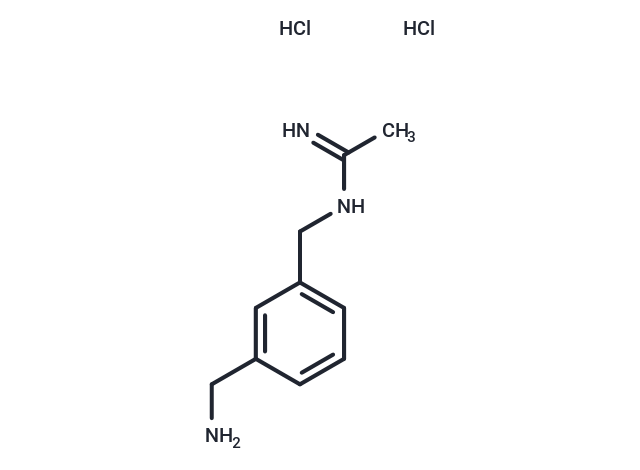Shopping Cart
- Remove All
 Your shopping cart is currently empty
Your shopping cart is currently empty

1400W dihydrochloride (N-(3-(Aminomethyl)benzyl)acetamidine) is a highly effective and specific inhibitor of inducible NOS2 (iNOS).

| Pack Size | Price | Availability | Quantity |
|---|---|---|---|
| 5 mg | $43 | In Stock | |
| 10 mg | $68 | In Stock | |
| 25 mg | $127 | In Stock | |
| 50 mg | $231 | In Stock | |
| 100 mg | $393 | In Stock | |
| 200 mg | $511 | In Stock | |
| 500 mg | $829 | In Stock | |
| 1 mL x 10 mM (in DMSO) | $48 | In Stock |
| Description | 1400W dihydrochloride (N-(3-(Aminomethyl)benzyl)acetamidine) is a highly effective and specific inhibitor of inducible NOS2 (iNOS). |
| Targets&IC50 | eNOS:50 μM(Ki), iNOS:<7 nM(Kd), nNOS:2 μM(Ki) |
| In vitro | 1400W is either an irreversible inhibitor or an extremely slowly reversible inhibitor of human iNOS. Inhibition of human iNOS by 1400W is time-dependent. 1400W is competitive with L-arginine. 1400W is not a substrate for iNOS[1]. |
| In vivo | 1400W selectively prevents microvasculature injury in rats. 1400W is greater than 50-fold more potent against iNOS than eNOS in a rat model of endotoxin-induced vascular injury. Moreover, 1400W also dose-dependently reduces LPS-induced vascular leakage associated with iNOS induction in the colon, lung, liver, kidney, and heart. The maximal protection is close to 100% for all organs except the kidney (kidney:54%)[1]. 1400W has an ameliorative effect on both oxidative and nitrosative stress in the kidneys against renal I/R injury in rats[2]. Treatment with 1400W can reduce the rate of growth of solid tumors in mice[4]. |
| Cell Research | RAW264.7 cells are treated with LPS/IFNγ for 16 h and GAPDH-p300 binding is abolished by the iNOS inhibitor 1400W (100 μM). Cell lysates are immunoprecipitated with an anti-p300 antibody and the immunoprecipitates are analysed by western blotting with an anti-GAPDH antibody. (Only for Reference) |
| Alias | N-(3-(Aminomethyl)benzyl)acetamidine, 1400W 2HCl |
| Molecular Weight | 250.17 |
| Formula | C10H17Cl2N3 |
| Cas No. | 214358-33-5 |
| Smiles | Cl.Cl.CC(=N)NCc1cccc(CN)c1 |
| Relative Density. | no data available |
| Storage | Powder: -20°C for 3 years | In solvent: -80°C for 1 year | Shipping with blue ice. | |||||||||||||||||||||||||||||||||||
| Solubility Information | H2O: 139.9 mM, Sonication is recommended. DMSO: 55 mg/mL (219.85 mM), Sonication is recommended. | |||||||||||||||||||||||||||||||||||
Solution Preparation Table | ||||||||||||||||||||||||||||||||||||
H2O/DMSO
| ||||||||||||||||||||||||||||||||||||

Copyright © 2015-2025 TargetMol Chemicals Inc. All Rights Reserved.